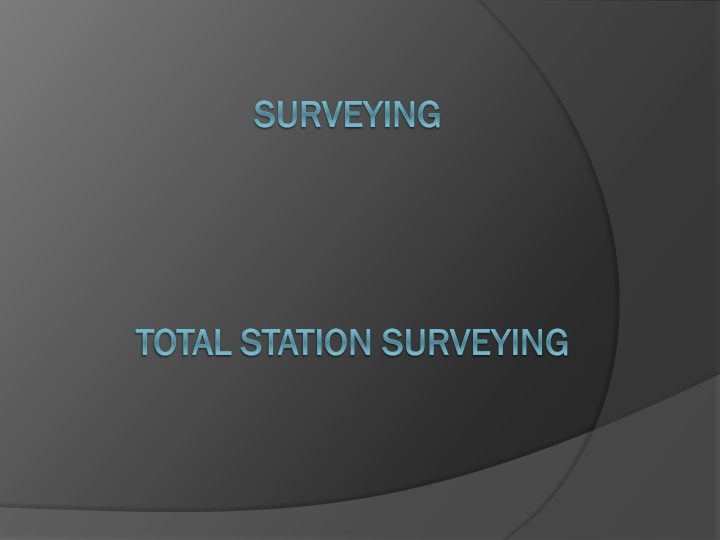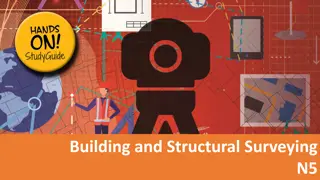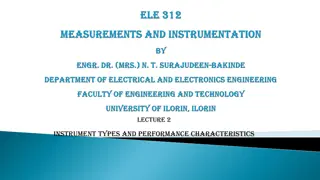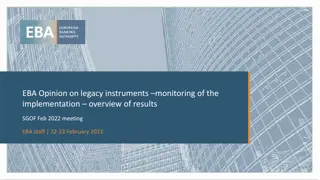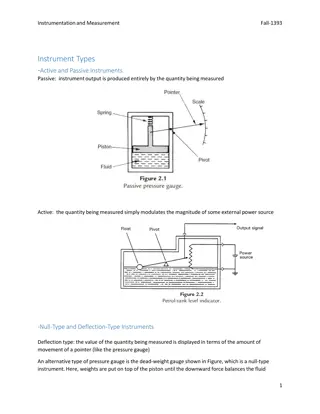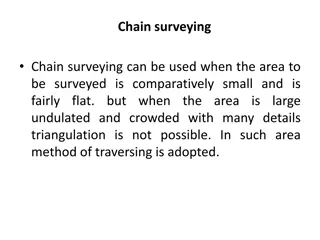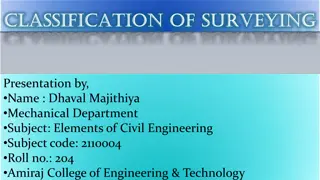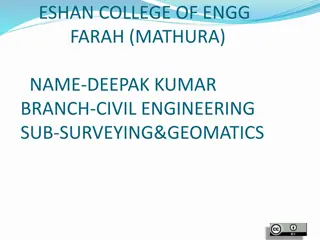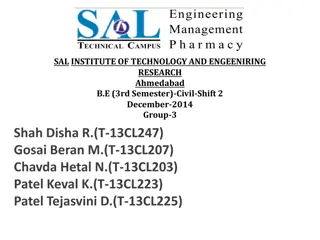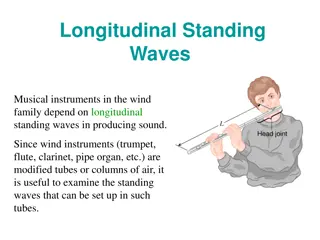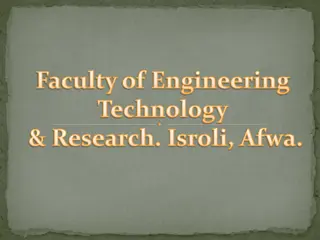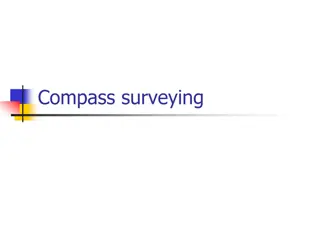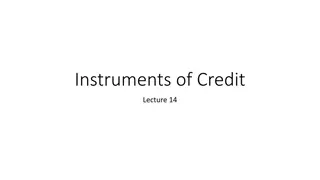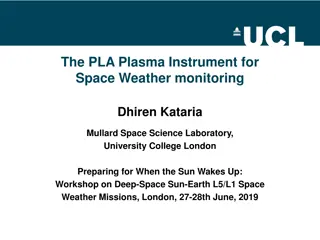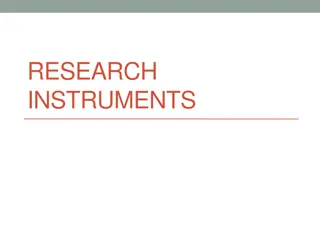Surveying Principles and Instruments
Surveying involves determining and recording earth features' relative positions, utilizing instruments like total stations, digital levels, and GPS for linear, angular, and height measurements. Different types of surveys include traverse, triangulation, and plane table. Advantages of digital levels include fatigue-free observation, automation for consistent precision, and fast data reduction.
Download Presentation

Please find below an Image/Link to download the presentation.
The content on the website is provided AS IS for your information and personal use only. It may not be sold, licensed, or shared on other websites without obtaining consent from the author.If you encounter any issues during the download, it is possible that the publisher has removed the file from their server.
You are allowed to download the files provided on this website for personal or commercial use, subject to the condition that they are used lawfully. All files are the property of their respective owners.
The content on the website is provided AS IS for your information and personal use only. It may not be sold, licensed, or shared on other websites without obtaining consent from the author.
E N D
Presentation Transcript
SURVEYING SURVEYING TOTAL STATION SURVEYING TOTAL STATION SURVEYING
Basic Principle Classifications Electro optical system measuring principle, Sources of Error Infrared and Laser total station Instruments. Microwave system , measuring principle, working principle, sources of Errors, Microwave instruments,comparision optical and Microwave maintenance of total Modern positioning systems , Traversing and Trilateration. principle working total station Electro and between system. station Care Instruments,
It is Process of determining It is Process of determining earthen features and earthen features and recording its relative recording its relative position on to the paper position on to the paper
Types of survey Traverse survey Triangulation survey Plane table survey Which includes: 1. Linear Measurements 2. Angular Measurements 3. Height Measurements
Linear measurements we usually do with: chain Tape Substance bar EDM (Electronic distance measurement instrument) GPS (Global Positioning System) Angular measurements we usually do with: Compass Theodolite Height we usually do with: Dumpy level Auto level Theodolite & Digital leveler
Advantages of Digital levels Fatigue-free observation as visual staff reading by the observer is not required. User friendly menus with easy to read, digital display of results. Measurement of consistent precision and reliability due to automation. Automatic data storage eliminates booking and its associated errors. Automatic reduction of data to produce ground levels, thereby eliminating arithmetical errors.
Fast, economic surveys resulting in saving in time (up to 50% less effort has been claimed by manufacturers) Data on the storage medium of the level can be downloaded to a computer enabling quick data reduction for various purposes. Digital levels can also be used as conventional levels with the help of dual marked staff (bar coded on one side of the staff for automated reading and conventional graduation on other side of the staff) in case it is difficult to record readings digitally (e.g. for long distances).
Capabilities of Digital levels measuring elevation measuring height difference measuring height difference with multiple instrument positions levelling slope setting setting out with horizontal distance levelling of ceilings
Total station is a combination of : EDM Theodolite Auto Leveler Microprocessor with specific memory Battery/spare which works about 5 working hours About 100 models were released till now by different firms.
Basic components of Total station Prism reflector: It is a combination of ranging rod, staff and and optical cuboidal mirror. having 2/3 lifts with 5cms interval graduations. adjustable height from 1.5m to 3.75m. More number of prisms, will give more accuracy.
GUN: data screen LCD eye piece telescope 24x to 43x environmental box microprocessor with memory card of 1 or 2 GB capacity 1MB can store 800 points. Tripod: with different material Aluminum tripod weighs 13 to 14lbs Wooden tripod will be about 18 lbs. Optical and Laser plumb bobs. Battery as an external attachment with indicators 1.5hours charged battery can work for 3to 5 hours
ACCURACY OF TOTAL STATION More accuracy can be achieve by : 1. Careful Centering 2. Accurate pointing target 3. Average of multiple points 4. Better optical lense 5. Strong Tripod 6. Verticality of prism pole 1. 2. 3. Angular accuracy is from 1 to 20 Sec. Linear accuracy is from 2mm to 10mm/per KM Different instruments have different accuracy Linear Angular With 1 Prism + 2 mm + 2 mm 2 mm With 3 prisms + 1 mm + 1 mm + 1 mm NIKON LIEKA SOKKIA 1 Sec 1 Sec 1 Sec Accuracy varies with Price Distance measure with: 1.Single Prism up to 2.5 Km 2.Two prisms - 5 to 7 Km 3.Three prisms - 10 to 12 Km
Functions of T.S: 1. It simultaneously measures angles & distances and Record 2. Correcting the measured distance with: 3. Computing the point elevation 4. Computing the coordinates of every point 5. Remote elevation measurement 6. Remote distance measurement 7. Area calculations 8. Data Transferring facility from instrument to S/W and S/W to instrument 9. Format of conversion of units 1. Prism constant 2. Atmospheric Pr. 3. Temperature 4. Curvature of earth 5. Refraction correction
REM Remote Elevation Measurement
RDM Remote Distance Measurement
Application of Total station: 1. Updating mapping 2. Topographic survey 3. Hydrographic survey 4. Cadastral survey 5. Project construction survey 6. Road, Rail Survey 7. Mining survey
Operations involved while using Total Stations : 1. Establishing the site Datum: a) Selecting the site Datum b) Establishing North 2. Setting up the Total station: a) Placing and leveling Tripod on Datum b) Placing and leveling the Gun on Tripod c) Linking the data connector to Gun 3. Data collector options and setting a) Main menu b) Basic settings
4. Creating and Operating Job files: a) Creating a new Job file b) Opening an existing file 5. Shooting points a) Identifying the important points to shoot b) shooting points c) Shooting additional points d) Noting the special features 6.Post Processing Data down loading,conversion 7.Plotting/Map generation.
Computer software packages The following post processing computer software packages are in use for various engineering applications. 1.Arc Pad, arc view, arc info -conversion from raster to vector form 2.Micro Station - Map generation 3.Erdas Image processing s/w 4.Surfer, Auto plotter, Civil cad, Pythagarus preparation of contours 5. Survey aid to draw c/s and l/s The information received is to be analyzed depending on the users requirement.
Limitations: 1. It is not a Rugged instrument (Sensitive). 2. Prism verticality is questionable. 3. Visibility is must. 4. More Expensive. 5. Requires calibration at every six months. 6. Amount of error is greater at short distances. 7. Height of instrument and prism is to fed. 8. Awareness on battery maintenance. 9. To establish north- compass is required.
SAFETY PRECAUTIONS Focusing directly at the sun, can result - loss of eyesight on the spot. Use a filter when observing the sun. 1. Never remove the hand grip carelessly. If the grip is loosely or incompletely attached, the instrument could fall and may cause a serious injury. 2. Make sure not to short the battery terminals. If these are shorted, the resulting high current would not only damage to the battery, but also start a fire. 3. If the instrument or battery comes in contact with water, wipe it off as quickly as possible and set it in a dry place for a while. When it is completely dry, put it back in the case. 4. 5. Never disassemble the instrument, if you find a problem. Contact the dealer.
HOW TO SUPERVISE THE TOTAL STATION WORK Have keen observation on the prism boy s attitude. When high precision is required, use the prism tripod, to avoid human error. The position of prism shall always be on hard surface instead of soft soil. Focusing shall be exactly at the centre of prism, with the help of cross hairs and prism plate. While measuring the instrument height and prism height, enough attention shall be diverted. Also, have keen observation while entering the above data. Note the location and coordinates of station point and back sight so that specified intermediate points can be checked at later date. Obtain a soft copy of field work raw data from the survey agency so that the results can be checked at any time. Obtain more number of points to get an average.
